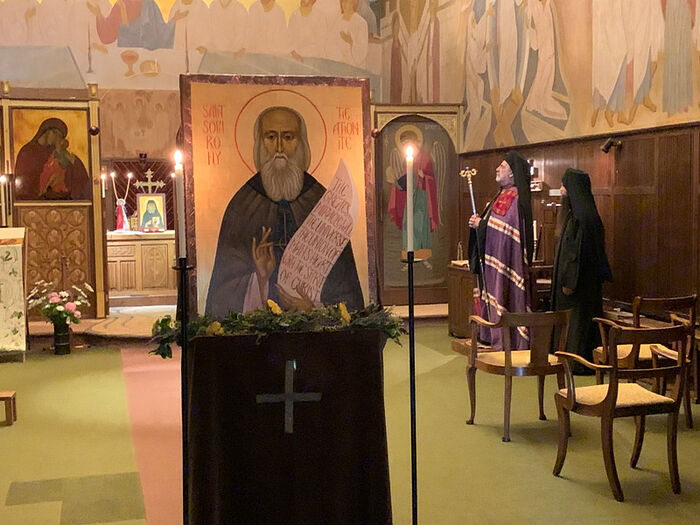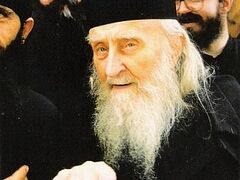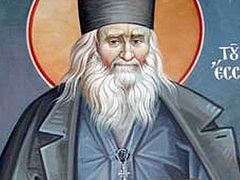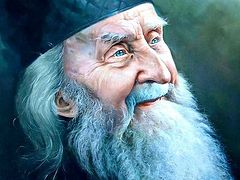Essex, England, July 14, 2020
The Monastery of St. John the Baptist in Essex, England, experienced a great spiritual joy on July 10-11 this year as it celebrated the feast of its founder St. Sophrony for the first time since his glorification among the saints late last year.
The feast was celebrated by Archbishop Nikitas of the Patriarchate of Constantinople and a number of other clergy, with Vespers being served in the evening of July 10 and Matins and Liturgy the following day.
In a talk offered on the feast, Abp. Nikitas spoke of St. Sophrony as a spiritual father who passed on the Tradition of the Church, flowing from the life of Christ, to innumerable spiritual children:
It would be impossible for us to determine the number of faithful and pious Christians who came to him from all corners of the globe for spiritual guidance and support over the years. His days and nights were spent in deep prayer, as he asked God to heal the broken hearts of the people. And, of course, this great saint did not give of his own wisdom and words; rather, he gave Christ and Christ’s words to those thirsty and hungry for righteousness, truth, and the heavenly kingdom. During his lifetime, St. Sophrony became a fountain of healing for those suffering in body and soul, especially as he gave peace and comfort to ease the pain of sin. He saw beauty in all things, especially nature and God’s creation. For him, the lilies of the field showed the creative hands that wove a masterpiece of wonder, while the birds of the air sang the praises of heaven in their own way.
Read the Archbishop’s full talk below.
Patriarch Bartholomew announced during a trip to Mt. Athos in October that the process of canonizing St. Sophrony was underway, and on November 27, he was glorified among the saints together with Elder Ieronymos of Simenopetra by the Holy Synod of the Patriarchate of Constantinople.
***
Most Respected Abbot and Elder, Fr. Petros,
Esteemed and Honourable Former Abbot and Geronta, Fr. Kyrillos,
Fathers, Brothers and Sisters of the sacred Patriarchal and Stavropegic Monastery,
Beloved Children in the Lord,
Grace and peace be with you in the name of the Lord Jesus Christ.
In his love for the world and humanity, our heavenly Father places saintly people in each and every era of human history to guide us, protect us, and keep us on the path of salvation. While these saints faced many challenges and difficulties in their lives, God called them and—because of the disposition of their hearts—He selected them and anointed them, as the Judges of old to save us from the power of those who would plunder us, the New Israel, with his grace and love; and they, in turn—almost appearing out of nowhere—reveal to us the true nature and meaning of God’s commandments. In other words, these saints, whom God placed in our lives for our own sake and for that of the entire world, revealed that the commandments of Christ are not simply external laws, but revelations of divine life. Indeed, through these holy men and women, we witnessed that God is love, and that God is humility. Through their examples, we find instruction in keeping “to the paths of the righteous,” (Proverbs 2) and we learn how to lead our lives in a saintly way.
As history has shown, we see the sacred and prophetic words of the Prophet and King Solomon come to life:
“The souls of the righteous are in the hand of God, and no torment will ever touch them. In the eyes of the foolish they seemed to have died, and their departure was thought to be an affliction, and their going from us to be their destruction; but they are at peace. For though in the sight of men they were punished, their hope is full of immortality. Having been disciplined a little, they will receive great good, because God tested them and found them worthy of himself; like gold in the furnace he tried them, and like a sacrificial burnt offering he accepted them. In the time of their visitation they will shine forth, and will run like sparks through the stubble. They will govern nations and rule over peoples, and the Lord will reign over them forever. Those who trust in him will understand truth, and the faithful will abide with him in love, because grace and mercy are upon his elect, and he watches over his holy ones.” (Wisdom of Solomon 3:1-9)
The Good Shepherd and Master saw the innocence and pure heart of the young Sergei, and watched over him, in a sense, waiting in anticipation for him to realize and respond to his true calling. After living in Russia during very turbulent times and having fallen away from the true path of Christ, he began to walk the path of a sacred pilgrimage, searching for the ideals that would quench his thirst for truth. Eventually, as we all know, he left his native land and family, journeying to various countries, and arrived at the Garden of the Virgin Mary, that is, the Holy Mountain of Athos, where he would cultivate seeds of humility, love, and prayer, which had been planted in his heart years before. While on Mt. Athos, he was guided and directed by other great ascetics and elders—saintly persons, such as St. Nikolai Velimirovic—who would assist him with his personal struggles and spiritual life. It was there that he became the disciple of St. Silouan, the great luminary and pillar of light, from whose heart sprung forth—as from a deep well—spiritual waters for St. Sophrony. It is clear that this refreshing spiritual guidance gave life to the blossoming flowers of love that were in St. Sophrony’s heart.
Over the years, St. Sophrony shared the wisdom and teachings that had been provided to him by all the Athonite elders, especially St. Silouan. In due course, however, he decided to live in quiet (hesychia) and cultivate the Jesus Prayer even more fully in his heart. Guided by the Spirit, St. Sophrony came to this blessed land—a land sanctified by the blood of its Martyrs and the choir of Saints of the British Isles; a land known as the pulpit of St. Aristoboulos, who was the First Bishop of Britain; a land known as the arena of the protomartyr St. Alban, as well as the land of King St. Edmund, and the noetic script of the Venerable Bede. Yes, it was here in the sacred area of Essex that he established the Monastery dedicated to the Forerunner and Baptist, St. John. This, certainly, was not by chance, though. For the Baptist, too, fled to the desert and sought peace, stillness, and silence—far from the noise, distraction, and violence of the world. Of course, the Baptist himself was not alone. After all, St. John had disciples and spiritual children within his paternal embrace. He directed them to Christ. And so, St. Sophrony, in a similar manner, gathered his children under his care—like a hen gathers her chicks under her wings—in order that he might gather them and lead them together towards Christ and His unwaning light.
As the great Prophet Elias passed his mantle unto his disciple Elijah, so the blessed Sophrony passed his mantle to Fr. Kyrillos and now to Fr. Petros, continuing the sacred tradition of monasticism once brought and planted here by this great saint. Many people today know St. Sophrony as a skilled theologian and iconographer. But his influence and deep personal commitment to Christ is not only seen in the sacred icons and theological writings that he produced. For instance, it would be impossible for us to determine the number of faithful and pious Christians who came to him from all corners of the globe for spiritual guidance and support over the years. His days and nights were spent in deep prayer, as he asked God to heal the broken hearts of the people. And, of course, this great saint did not give of his own wisdom and words; rather, he gave Christ and Christ’s words to those thirsty and hungry for righteousness, truth, and the heavenly kingdom. During his lifetime, St. Sophrony became a fountain of healing for those suffering in body and soul, especially as he gave peace and comfort to ease the pain of sin. He saw beauty in all things, especially nature and God’s creation. For him, the lilies of the field showed the creative hands that wove a masterpiece of wonder, while the birds of the air sang the praises of heaven in their own way.
On this most joyous of occasions, we are gathered together as a community of pilgrims and stand as one family celebrating the holiness of the life of St. Sophrony. We have come here, each of us, to bend our knees and ask not only for his blessing, but also for his prayers and intercessions before the throne of God. As he served at the Altar here on earth, we now ask that he pray for us at the celestial Altar in the heavens. As the hymns of the service tell us, St. Sophrony is like a trumpet, sounding loud the truth of Christ and we have gathered here in Essex to hear the musical message of love that radiates from his grave.
The Holy and Great Church of Christ, the Ecumenical Patriarchate, recognized the sanctity of Sophrony’s life, and he was formally numbered among the Saints of the Church. Within the depths of the hearts of the people of God, though, he was already accepted as such even during his life. The Church invites the faithful throughout the world to give him the proper honour we offer the true children of God. His All-Holiness Ecumenical Patriarch Bartholomew had hoped to be here and serve on this most blessed and sacred day, but the unfortunate circumstances around the world did not allow for it. Nevertheless, our Patriarch and the venerable hierarchs of the Mother Church of Constantinople are noetically near us all on this day and share with us in the joy of this heavenly celebration. Naturally, I come not in place of His All-Holiness, but rather with paternal love and blessing, so I might also share in the joy, honour, and blessings of this first celebration of the feast of St. Sophrony of Essex, the Athonite, the Elder, the Teacher, and the Father.
It was prevalent in St. Sophrony’s teachings that the institutions of the Church are a gift of the Holy Spirit. Thus, it is of the utmost importance that we work together here in strengthening the Christian presence and witness of these lands. May our collaborations be characterized by the nobility of his spirit, especially since St. Sophrony always treated everyone around him with great deference, as though they were nobility—a sentiment for which our broken and divided world is currently in great need. Therefore, at this time, I entreat St. Sophrony to help us with building up the Church here, and to help in preserving and protecting our Ecumenical Patriarch, the Mother Church, and all those labouring for its rights and equality.
England, the United Kingdom, and the entire oikoumene are now blessed by St. Sophrony, who gave to the world his most precious possession—his heart filled with love for Christ. Being here present with all of you today, my own heart sings the sacred words from Matins:
“O blessed land of Britain, within you, you received the precious and holy relic of St. Sophrony the Wonderworker, whom the Lord made worthy to become a venerable dwelling of the Holy Spirit, which endlessly gushes forth, to those who with true faith approach, the gifts of Divine grace.”
Rejoice, then, people of God, and give thanks and praise—that in our day and time our heavenly Father has not forgotten our world. We celebrate the life of this great luminary and are comforted that we have been found worthy to live in the shadow of his grace. May we have his blessings from above, so we also learn to walk in the light of Christ.
***
St. Sophrony (1896-1993) is especially known as the spiritual child and biographer of the great St. Silouan the Athonite and the founder of the monastery in Essex.
He was ordained to the diaconate on Mt. Athos in 1930 by St. Nikolai Velimirovic and became a disciple of St. Silouan at the Russian St. Panteleimon’s Monastery. After the repose of his elder in 1938, St. Sophrony retreated into the Athonite desert from 1939-1945. He was ordained to the priesthood in 1941.
In 1942, he produced the first version of the biography and teachings of St. Silouan while living in Paris, with expanded editions to follow in the subsequent decades.
St. Sophrony founded the monastery in Essex in 1958, for both monks and nuns, serving as its first abbot for many years. In 1965, it moved from the Moscow to the Constantinople Patriarchate. During this time, he began to publish his own writings, such as His Life is Mine, and We Shall See Him as He Is.
St. Sophrony reposed in the Lord on July 11, 1993.





